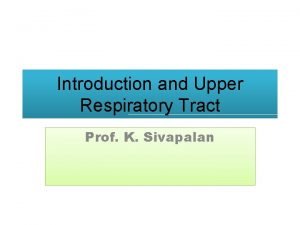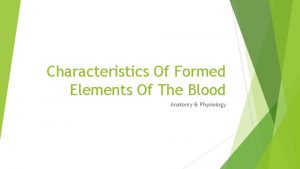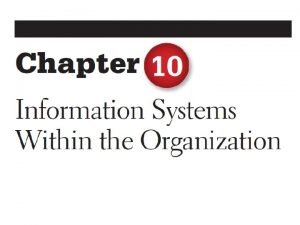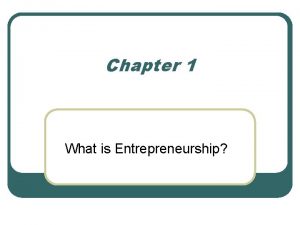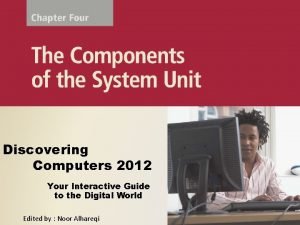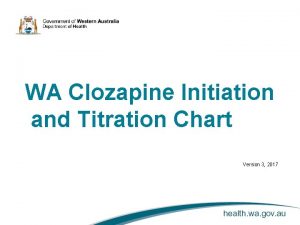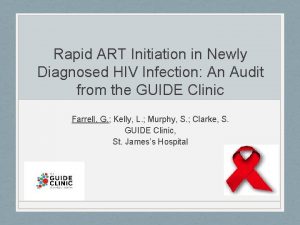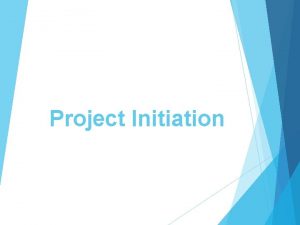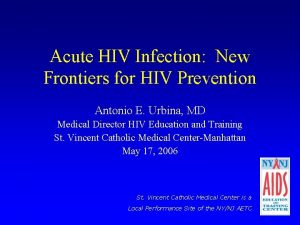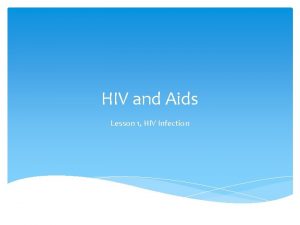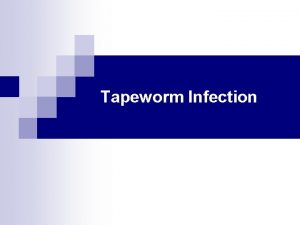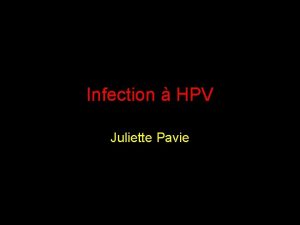Early ART initiation in acute HIV infection generates














- Slides: 14


Early ART initiation in acute HIV infection generates long-lived memory HIV-specific CD 8+ T cells endowed with efficient proliferative and cytolytic recall response Hiroshi Takata @Twitter. Handle Share your thoughts on this presentation with #IAS 2019 The views expressed are those of the authors and should not be construed to represent the positions of the U. S. Army, the Department of Defense, or HJF.

Disclosure The author has no conflict of interest to disclose. The views expressed are those of the authors and should not be construed to represent the positions of the U. S. Army, the Department of Defense, or HJF.

HIV-specific CD 8+ T cells in acute and treated HIV infection • HIV-specific CD 8+ T cells become dysfunctional after peak viremia in acute HIV infection (AHI) • Initiation of ART during AHI improves cytokine productivity and memory potential of HIV-specific CD 8+ T cells after 1 month of treatment Trautmann Blood 2012, Ndhlovu Immunity 2015, Takata Sci Transl Med 2017, Ndhlovu Sci Transl Med 2019 Treated from chronic HIV infection (CHI): ART restores polyfunctionality, and partially normalizes activation, exhaustion markers, and IL-7 R. Rehr M, J Virol. 2008. , Janbazian L, J Immunol. 2012. , Vigano S, J Virol. 2015. , Mahnke YD, Pathog Immun 2016. Majority of HIV-specific CD 8+ T cells are found in transitional memory subset in contrast to yellow fever vaccine induced memory CD 8+ T cells which are found in long-lived memory subsets. Akondy R, et al. Nature 2017. , Fuertes Marraco SA, et al. Sci Transl Med. 2015. , Buggert M, et al. PLo. S Pathog. 2014.

Questions • Does early initiation of ART from different stages of AHI induce more functional memory CD 8+ T cells compared to treating in chronic HIV infection? • Memory T cell differentiation status • Magnitude and quality of secondary response Study population Fiebig stage # of Cohort ART initiated participants Fiebig I-V RV 254 34 Chronic SEARCH 011 12 Duration of ART (Wks) 107 (48 -192) 127 (48 -196) All PBMC samples were obtained after more than 1 year of suppressive ART. HLA-A*1101 restricted HIV-Nef/ Pol and EBV-specific CD 8+ T cells were analyzed.

Secondary HIV-specific CD 8 T cell response in vitro Day 0 Day 6 Day 12 Day 13 Label with Cell Trace dye X X +HIV epitope peptide, 2. 4 Target only 38. 2 With Effector ET ratio: 2 50 50 26 74 Peptide+ Peptide- Cell Trace Violet HLA-A 11 CD 4 HIV Nef Isolate CD 4+ T cells Peptide+ Peptide. Labeled with CFSE Peptide- CD 8 CD 4+ T cells Peptide+ HLA-A 11 HIV Nef HIV-specific CD 8+ T cells 0. 4 Coculture Phenotyping Expand with PHA+IL-2 ARVs HLA-A 11 HIV Nef PBMCs from individuals on ART more than 1 year Phenotyping X X Cell Trace Violet CFSE Specific lysis: 65%

Participants treated from acute HIV infection have lower frequency and cell number of HIV-specific CD 8+ T cells than treated chronic HIV infection Percentage in total CD 8+ T cells Absolute cell number in peripheral blood Fiebig III Fiebig IV/V Chronic EBV-specific

Initiation of ART in acute HIV infection promotes differentiation of memory CD 8+ T cells with self-renewal and long-lived phenotype Self-renewal Long lived Fiebig III Fiebig IV/V Chronic EBV-specific Cell survival IL-7 receptor

HIV-specific CD 8+ T cells from people treated from AHI expand better than those from people treated from chronic HIV infection Day 6/ Day 0 Day 12/ Day 0 Fiebig III Fiebig IV/V Chronic EBV-specific

Magnitude of the recall response correlates with characteristic of long-lived memory CD 8+ T cells Self-renewal and cell survival Fiebig III Fiebig IV/V Chronic

Recalled HIV-specific CD 8+ T cells from people treated from AHI have superior killing capacity than those from treated from CHI CFSE killing assay with day 13 recalled A 11 HIV Nef GK 10 -specific and EBV-specific CD 8+ T cells Ex vivo HIV-specific CD 8+ T cells Recalled HIV-specific CD 8+ T cells Fiebig III Fiebig IV/V Chronic EBV-specific

High PD-1 expression status is imprinted in HIV-specific CD 8 + T cells from treated from chronic infection even after secondary response Fiebig III Fiebig IV/V Chronic

Conclusion 1. Early ART in acute HIV infection promotes differentiation of long-lived memory CD 8 + T cells that have higher expansion and cytotoxic capacity after recall than those in people treated from chronic infection 2. Even after suppressive ART, recalled HIV-specific CD 8+ T cells from individuals treated from chronic infection are exhausted based on their upregulated PD-1 expression and dampened effector function 3. HIV remission strategies in people treated in chronic infection will likely require a combination of reversing T cell exhaustion and boosting the HIV-specific CD 8 + T cell response

RV 254 and Search 011 participants U. S. MHRP Nelson Michael Sandhya Vasan Merlin Robb Robert Gramzinski Jintanat Ananworanich Julie Ake Diane Bolton Morgane Rolland Sodsai Tovanabutra Rasmi Thomas Mark de Souza Linda Jagodzinski Shelly Krebs Trevor Crowell Suteera Pinyakorn Flow Core UCSF Victor Valcour Acknowledgements MHRP Cellular Immunology Section Lydie Trautmann Caroline Subra Julie Mitchell Noemia Lima Faria Fatmi Jueyon Kakazu Shu-Wei Wu Kelsi Jameson Kenneth Dietze Alexander Haregot Nikiah Dawson AFRIMS Robert O’ Connell Alexandra Schuetz Siriwat Akapirak Denise Hsu Rapee Trichavaroj Bessara Nantapinit Pornsuk Visudhiphan COG Thai Red Cross Praphan Phanuphak Nipat Teeratakulpisarn Nittaya Phanuphak Eugene Kroon Donn Colby Nitiya Chomchey Carlo Sacdalan James Fletcher Pornpen Tantivitayakul Phillip Chan Jintana Intasan Many more Chulalongkorn U Supranee Buranapraditkun Sunee Sirivichayakul Rungsun Rerknimitr Sukalya Lerdlum Phandee Wattanaboonyongcharoen Sopark Manasnayakorn Montréal U Nicolas Chomont Louise Leyre Remi Fromentin Industry Thai Gov Pharm Organization Vii. V Healthcare Gilead Merck Monogram Drexel U Elias Haddad Roshell Muir Funding from U. S. MHRP Program, R 01 AI 108433, R 01 MH 106466
 Lyphadenitis
Lyphadenitis Broncheols
Broncheols Active phagocytes that increase rapidly acute infection
Active phagocytes that increase rapidly acute infection Regular grammars generate regular languages
Regular grammars generate regular languages A transaction is any business event that generates
A transaction is any business event that generates Leadership sytle
Leadership sytle Public provision example
Public provision example People who own, operate, and take risk of a business
People who own, operate, and take risk of a business Generates fresh produce and other farm products
Generates fresh produce and other farm products Generates fresh produce and other farm products
Generates fresh produce and other farm products Discovering computers 2012
Discovering computers 2012 Early cpr and early defibrillation can: *
Early cpr and early defibrillation can: * Clozapine titration chart
Clozapine titration chart Rho independent termination
Rho independent termination Supreme ordeal in the odyssey
Supreme ordeal in the odyssey

